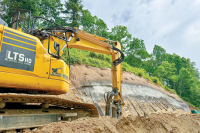We can’t stop the changes
Some have charged that the true, underlying sentiment among those who support stringent development regulations in Jackson County — and elsewhere in Western North Carolina — is a desire to stop all growth and keep newcomers away. Build a wall, so to speak.
The illustration by artist Mandy Newham that graced our cover a couple of weeks ago depicted that line of thought. That drawing, it seems, proved fortuitous.
In it, a developer is saying that he does everything the right way and shouldn’t be kept out of Western North Carolina. That developer who does things the right way is how most feel about Balsam Mountain Preserve’s owners. They were known for going the extra mile when it came to protecting the environment, and its parent company helped create the model for eco-friendly developments where a considerable portion of the land is protected, development regulations are strict, and no costs are spared to build roads and other amenities that work with the environment, not against it.
Two weeks ago, however, that perception was put to the test as a dam break on June 7 unleashed hundreds of tons of sediment into Sugar Loaf and Scotts creeks, mud that wreaked havoc on these waterways before making its way into the Tuckasegee River and doing additional damage there. Regulators are still assessing the damage, but it was significant. Fish, insects and other aquatic life were killed en masse.
There are many lessons to be learned from this incident, but one that stands out is the inevitability of unintended consequences. Like it or not, the future brings with it change, and some of that change — whether accidental or just not expected — we can’t foresee. Once we accept that as truth, it’s easy to accept the conclusion that planning for all the changes that we can predict is a good idea.
A river of mud
What happened at Balsam Mountain Preserve was an accident of the worst kind. How it happened is still being investigated, and it’s not known yet if a culprit will turn up. Did the dam builders not do their job? Was the developer trying to cut corners? Could engineers or surveyors have made honest yet disastrous mistakes in their calculations? Or did underground springs cause the earthen dam to collapse?
The dam was built a year ago as part of the development’s golf course. Investigators with the state are speculating that water seeped in around a drainage pipe, weakening the dam and eventually causing it to burst. Once that happened, hundreds of tons of sediment roiled down the mountain. Some estimate the damage from the disaster extends along 30 miles of creeks and rivers all the way to Fontana Lake. Mark Cantrell with the U.S. Fish and Wildlife Service said the devastation is severe, and he and others are trying now to gauge the impact on a colony of endangered elktoe mussels that live in the Tuckasegee.
Doug Hoffman with Balsam Mountain Preserve promises a clean up and restoration that will make the river and its stream banks better than before. Fines of up to $400,000 could be levied, and the company will also be responsible for removing as much sediment as is determined washed into the river. Hoffman says they’ll take out more than went in.
Railing against ... change
Perhaps it will be determined that there is a culprit here, that someone was trying to cut corners or simply did not have the knowledge needed to build a dam of this kind. Perhaps it will go down as an accident no one could have foreseen.
For many, it will simply lead to more resentment toward all of those who work in the development, real estate and construction industry. As new housing developments and communities pop up in coves everywhere, blaming those who are responsible for those developments is easy enough. But that is misplaced blame.
WNC is more prosperous than it was 25 years ago, and part of the reason is second-home development. Growth is happening in these mountains because it is a desirable place to live. This region could have slogged along vainly trying to make up for jobs lost as almost all of our industries shut down. Instead, those lost jobs have hardly been felt because the second-home and tourism sectors have grown so quickly. Perhaps we should count our region fortunate to be growing — in population and economically — so rapidly.
Certainly Balsam Mountain Preserve should have to make good on the damage it caused. That much is obvious, and the company says it’s ready to do that. Stringent regulations on development and its effect on waterways and other habitat are absolutely vital, and nearly every county in the region is tackling this problem in some way or another (some better than others).
But that wall simply can’t be built, no more than any of us can stop the aging process in our lives. That’s really what the wall symbolizes, the resentment most everyone has toward change. The world isn’t gonna stop spinning. No, it’s just up to us to make that change as easy to live with as we can. Accomplishing that is much, much more difficult than dreaming that keeping everyone else out is going to solve our problems.
(Scott McLeod can be reached at This email address is being protected from spambots. You need JavaScript enabled to view it..)





